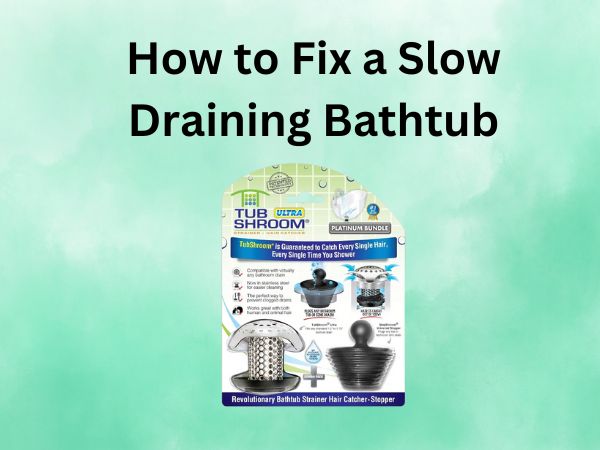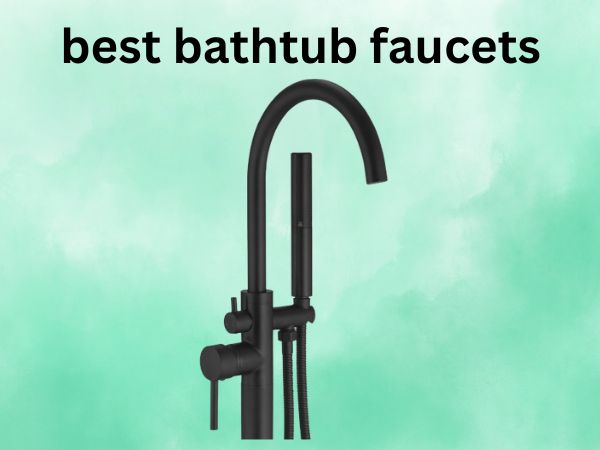How to Fix a Slow Draining Bathtub [In 2025]
Is there anything more frustrating than standing ankle-deep in soapy water during your shower? A slow draining bathtub is not just annoying—it’s a warning sign that something’s amiss in your plumbing system. The good news? You don’t need to be a professional plumber to tackle this common household issue. In this comprehensive guide, I’ll walk you through everything you need to know about diagnosing and fixing a sluggish bathtub drain, from simple DIY solutions to knowing when it’s time to call in the experts.
Table of Contents
Understanding the Causes of Slow Bathtub Drains
Before diving into solutions, let’s get to the root of the problem. Understanding what’s causing your bathtub to drain slowly will help you choose the most effective fix.
Hair and Soap Scum Buildup
The most common culprit behind slow bathtub drains is a combination of hair and soap scum. Every time you shower, hair naturally falls out and gets washed down the drain, where it can tangle and create a net-like obstruction. This “hair net” then catches soap residue, creating a sticky, stubborn clog that grows larger over time.
Think of it as building a dam in your pipes—piece by piece, day by day, until water can barely squeeze through. That’s why bathtub drains tend to slow gradually rather than clog completely all at once.
Mineral Deposits
If you live in an area with hard water, mineral deposits could be contributing to your drainage issues. Calcium and magnesium particles in hard water can accumulate along pipe walls, narrowing the passage for water to flow through.
These mineral deposits are like arterial plaque for your plumbing—they build up slowly but surely, restricting flow more and more as time passes.
Foreign Objects
Sometimes the culprit is something unexpected. Small items like children’s toys, bottle caps, or even jewelry can find their way into your drain and create blockages. I once discovered my daughter’s tiny rubber duck was the source of our bathroom drain woes!
Deeper Plumbing Issues
In some cases, slow drainage points to problems deeper in your plumbing system. Tree roots infiltrating underground pipes, collapsed pipes, or improper pipe grading can all cause drainage issues that affect your bathtub.
Essential Tools for Unclogging Your Bathtub
Before rolling up your sleeves, make sure you have the right tools on hand. Being prepared will save you multiple trips to the hardware store.
Basic Household Tools
Many effective drain-clearing solutions use items you probably already have at home:
- Rubber gloves (trust me, you’ll want these)
- Old towels or rags
- Bucket
- Flashlight
- Screwdriver (to remove drain covers)
- Kettle or pot for boiling water
- Baking soda and white vinegar
- Dish soap
Specialized Plumbing Tools
For more stubborn clogs, these specialized tools can make a big difference:
- Plunger (preferably a cup-style plunger designed for flat surfaces)
- Drain snake or auger (available in manual and electric versions)
- Zip-it tool (inexpensive plastic tool designed to grab hair)
- Drain removal tool (for removing pop-up stoppers)
Chemical Drain Cleaners
While I generally recommend trying mechanical methods first, sometimes chemical solutions have their place:
- Enzymatic drain cleaners (environmentally friendly, good for regular maintenance)
- Caustic drain cleaners (stronger, but harder on pipes)
- Acid-based drain cleaners (strongest type, use with extreme caution)
DIY Methods to Fix a Slow Draining Bathtub
Let’s start with the simplest solutions first. You’d be surprised how often these easy fixes do the trick!
Boiling Water Flush
Sometimes, the simplest solution works wonders. Boiling water can dissolve soap scum and help break down organic material causing the clog.
- Bring a large pot of water to a rolling boil
- Carefully pour it directly into the drain in 2-3 stages, allowing each pour to work for a few minutes
- Test the drain by running water from the tap
This method works best for soap scum and light clogs. It’s not effective for hair clogs or more serious blockages, and you should avoid this method if you have PVC pipes, as boiling water can damage them.
Baking Soda and Vinegar Method
This classic household remedy creates a natural chemical reaction that can break down many types of clogs without harsh chemicals.
Step-by-Step Process
- Remove any standing water from the tub
- Pour about 1 cup of baking soda directly into the drain
- Follow with 1 cup of white vinegar
- Watch for the fizzing reaction (that’s the magic happening!)
- Cover the drain with a plug or rag for about 30 minutes
- Flush with hot (not boiling) water
- Repeat if necessary
Why This Works
The combination of baking soda (a base) and vinegar (an acid) creates a bubbling, fizzing reaction that helps dislodge gunk and buildup. The mechanical action of the bubbles combined with the cleaning properties of both ingredients makes this an effective and pipe-friendly solution.
I’ve used this method quarterly as preventative maintenance, and it keeps my drains flowing smoothly year-round.
Manual Removal of Hair and Debris
Sometimes the most effective approach is also the most direct. Manually removing visible debris can quickly solve your drainage problem.
- Remove the drain cover or stopper (this usually involves unscrewing it or pulling it out)
- Using a flashlight, look for visible hair or debris
- Wear gloves and use your fingers, tweezers, or a wire hook to pull out as much material as possible
- Clean the stopper thoroughly before replacing it
It’s amazing—and slightly gross—to see how much hair can accumulate in a drain. A single cleaning session can often restore proper drainage immediately.
Plunger Technique
A plunger isn’t just for toilets! It can be highly effective for bathtub drains too.
- Remove the overflow plate and cover the overflow opening with a damp cloth
- Add enough water to the tub to cover the plunger’s rubber cup
- Place the plunger over the drain and ensure a good seal
- Plunge vigorously for 30-60 seconds with quick up and down movements
- Test the drain
The suction created by plunging can dislodge many types of clogs, pushing them through the system or pulling them up where you can remove them.
Using a Drain Snake or Auger
When simpler methods fail, a drain snake or auger allows you to reach deeper into your plumbing to address stubborn clogs.
Choosing the Right Drain Snake
Drain snakes come in several varieties:
- Manual hand augers (good for most household clogs)
- Drum augers (more powerful, with longer reach)
- Electric augers (for serious blockages)
For most bathtub clogs, a basic 25-foot manual auger will suffice. These typically cost between $15-$30 at hardware stores and are a worthy investment for any homeowner.
How to Use a Drain Snake Effectively
- Remove the drain cover or stopper
- Insert the end of the snake into the drain opening
- Turn the handle clockwise while pushing the snake deeper into the pipe
- When you feel resistance, you’ve likely reached the clog
- Rotate the snake to hook onto the material or break it up
- Slowly pull the snake back out, bringing debris with it
- Run hot water to test drainage and flush away loosened material
Using a drain snake takes some practice, but once you get the hang of it, you’ll feel like a plumbing pro!
Troubleshooting Common Issues
- If the snake won’t advance, try rotating it while applying gentle pressure
- If you can’t seem to grab the clog, try withdrawing the snake and checking for debris
- For very stubborn clogs, you may need to snake the drain several times
- If water still drains slowly after snaking, the clog may be further down the line
When to Use Chemical Drain Cleaners
I generally recommend trying mechanical methods first, as they’re less harmful to your pipes and the environment. However, chemical cleaners can be effective in certain situations.
Types of Chemical Cleaners
There are three main categories of chemical drain cleaners:
- Enzymatic/Bacterial Cleaners: These use beneficial bacteria or enzymes to digest organic matter like hair and soap scum. They’re slower but gentler on pipes and safer for the environment. These are excellent for monthly maintenance.
- Caustic Cleaners: Containing ingredients like lye or potash, these work by creating heat and converting grease into soap that dissolves in water. Effective but can damage older pipes with repeated use.
- Acidic Cleaners: The strongest type, containing sulfuric or hydrochloric acid. These should be a last resort before calling a plumber, as they can damage pipes, fixtures, and are extremely hazardous.
Safety Precautions
Chemical drain cleaners require careful handling:
- Always wear eye protection and rubber gloves
- Never mix different drain cleaners together
- Ensure good ventilation
- Keep children and pets away during and after application
- Store products safely out of reach
- Follow product instructions precisely
Application Methods
For best results when using chemical cleaners:
- Remove standing water from the tub
- Measure the exact recommended amount
- Pour slowly directly into the drain
- Allow the recommended time for the product to work (usually 15-30 minutes)
- Flush thoroughly with water according to product directions
Remember, more is not better when it comes to chemical cleaners. Using too much can damage your plumbing system.
Preventative Maintenance
As with most household issues, prevention is better than cure. Regular maintenance can keep your bathtub draining smoothly and prevent frustrating clogs.
Regular Cleaning Routines
Adopt these simple habits to prevent future drain problems:
- Clean visible hair from the drain after each shower
- Flush drains with hot water for 30 seconds after each use
- Perform a baking soda and vinegar treatment monthly
- Use a drain cleaner formulated for prevention once a month
Drain Protectors and Strainers
Installing a simple drain protector or strainer is one of the most effective preventative measures you can take. These inexpensive devices catch hair and large debris before they enter your plumbing.
I recommend a TubShroom or similar product that fits inside the drain rather than over it. These catch hair remarkably well while still allowing water to flow freely, and they’re easy to clean.
Monthly Maintenance Tips
Mark your calendar for these monthly drain-care tasks:
- Remove and clean drain stoppers and strainers
- Pour a pot of hot (not boiling) water down the drain
- Use an enzymatic cleaner to maintain clear pipes
- Check for slow drainage and address issues before they worsen
These simple steps take just minutes but can save you hours of unclogging work later on.
When to Call a Professional Plumber
While many bathtub drainage issues can be resolved with DIY methods, some situations call for professional expertise.
Signs of Serious Plumbing Problems
Consider calling a plumber if:
- Multiple drains in your home are backing up simultaneously
- You hear gurgling sounds from drains or toilets
- There are foul odors coming from drains despite cleaning
- Water backs up into sinks or tubs when you flush the toilet
- Your bathtub drain problems recur despite multiple DIY attempts
- You suspect a collapsed pipe or tree root intrusion
These symptoms may indicate issues beyond the bathtub itself, potentially affecting your main sewer line.
Cost Considerations
Professional drain cleaning typically costs between $100-$275, depending on the complexity and your location. While this is more expensive than DIY methods, a professional can often provide a more thorough and lasting solution.
For comparison, most DIY methods cost less than $30 in materials, making them worth trying first for simple clogs.
Finding a Reliable Plumber
If you do need professional help:
- Ask friends and neighbors for recommendations
- Check online reviews and ratings
- Verify licensing and insurance
- Get estimates from 2-3 plumbers
- Ask about guarantees on the work
A good plumber won’t just fix your current issue but can provide advice on preventing future problems.
FAQs About Fixing Slow Draining Bathtubs
1. How often should I clean my bathtub drain to prevent clogs?
For regular maintenance, clean your drain protector after each use and perform a deeper clean (like the baking soda and vinegar method) once a month. If you have long hair or multiple people using the shower, you might need to increase the frequency to every two weeks.
2. Can I use Drano or other chemical cleaners in my bathtub?
While chemical cleaners can be effective, they should be used sparingly and according to manufacturer instructions. Repeated use can damage pipes, especially in older homes. Always try mechanical methods first, and use enzymatic cleaners for regular maintenance as they’re gentler on your plumbing system.
3. Why does my bathtub drain smell bad even after cleaning?
A persistent odor could indicate biofilm buildup deeper in the pipes or a dry P-trap. Try an enzymatic cleaner specifically designed to break down biofilm, and make sure water is running through the drain regularly to keep the P-trap sealed, which prevents sewer gases from entering your bathroom.
4. Can a slow draining bathtub lead to more serious plumbing problems?
Yes, ignoring a slow drain can lead to complete blockages over time. Standing water can also damage your tub, surrounding grout, and even leak through to ceilings below if you’re in a multi-story home. Addressing slow drainage promptly prevents these more serious issues.
5. Is it normal for bathtubs to drain slowly after years of use?
While gradual slowing is common as pipes age and accumulate buildup, a properly maintained drain should still function well. If your bathtub has always drained slowly, there might be an installation issue like improper venting or pipe gradient that requires professional assessment. Modern plumbing should provide efficient drainage throughout its lifespan.
Conclusion
A slow draining bathtub doesn’t have to ruin your daily shower routine. With the right approach, most drainage issues can be resolved quickly and inexpensively at home. Start with simple solutions like the baking soda and vinegar method or manual removal of debris. If those don’t work, progress to using a drain snake or carefully selected chemical cleaners.
Remember that regular maintenance is your best defense against future clogs. Installing a drain protector and performing monthly cleaning routines will keep your bathtub draining smoothly for years to come.
By understanding what causes slow drainage and having the right tools on hand, you’re well-equipped to tackle this common household challenge. And if all else fails, don’t hesitate to call a professional—sometimes their specialized equipment and expertise are worth the investment.


